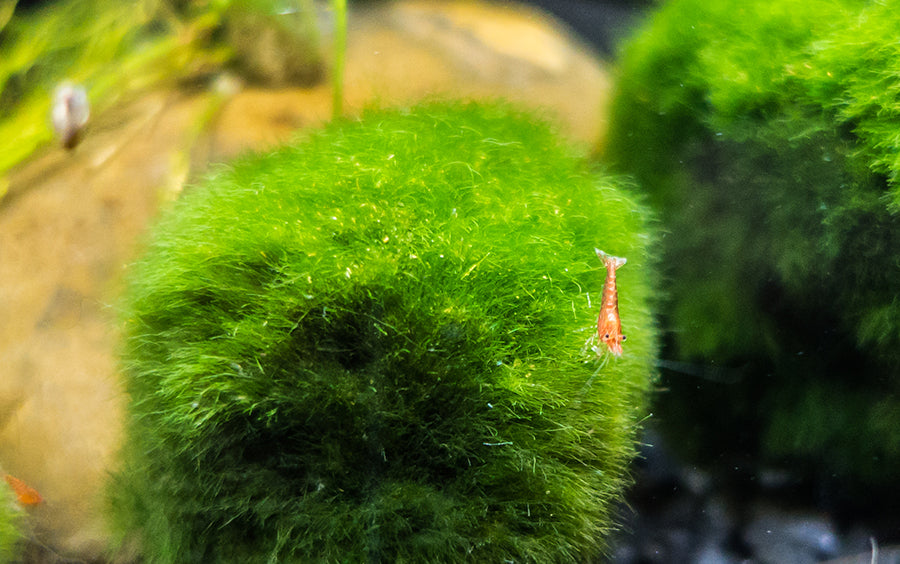Keeping and Breeding Cherry Shrimp – Neocaridina davidi
As an easy addition to your community tank that’s also simple to keep, cherry shrimp are increasingly popular. These little freshwater crustaceans grow to be about 1.5” in length. Like their saltwater cousins, they have a curved body, small legs, and spend most of their time seeking shelter in tank plant life and eating. In this article, we’ll talk about the basics of both keeping and breeding cherry shrimp.
The Cherry Shrimp Diet
Keep your shrimp healthy by giving them a great diet, consisting of algae and high-quality shrimp food. These shrimp also are natural tank cleaners, searching for tiny bits of bacteria and fish food that has not been eaten in the substrate, mosses, and on plant life. Since they’re continuously molting and shedding their exoskeleton, you also want to make sure to include calcium in their diet. This can be done by adding small amounts of crushed coral to the substrate or filter.
Shrimp are, well, shrimp! So, they’ll be preyed upon by other fish. Our rule of thumb is if it can fit in its mouth then it's a predator. If you want to ensure they won't get eaten make sure you don’t have anything in the tank that’ll go after them. However, when provided with enough hiding spaces shrimp can co-exist with larger fish, but there will always be a risk. Cholla wood and moss make great hiding spots. When it comes to fish they’re best with more docile species.

Bettas are notorious for going after shrimp.
Cherry Shrimp Color Grades

When it comes to cherry shrimp, you want the most beautiful deep red color. It’s really what makes these a striking addition to your tank. When looking to purchase one, you’ll come across several names for them depending on their color: Sakura, Fire Taiwan, Painted Fire Red, blue ones, and even yellow ones. The painted color scheme is a shiny, nail polish red, while the other colors are a deeper, brighter red. Normally, the female cherry shrimp (identified by her thick rounded tail and "saddle" back) will be brighter in color than male cherry shrimp.

Blue cherry shrimp AKA blue velvet shrimp
To simplify things and make it easier on you to select the shrimp you want, we split them into two categories: high grade or low grade. The high grade is very red, and the low grade is not as red. You’ll know what to look for when you’re shopping for these little guys – pick the ones that have the best color, not necessarily have the same name to go with them.

The higher the grade, the better the color. However, the name itself has little to do with the actual grade. It’s best to compare these different shrimp colors in an aquarium pet store because it’s difficult to compare them online. In person, you can see the differences in color.

Our high-grade cherry shrimp at Aquarium Co-op
You might see a Sakura cherry shrimp that has a better color than a Fire Taiwan, which should be of a higher grade. It can honestly get both confusing and misleading for the customer. Our mantra is to “buy what you see, not what you read.”
So, regardless of the name, buy the shrimp that have the best color. Even in one batch from one breeder, you’ll see quite the array of color options. They could be called Sakura, Fire Taiwan, or Painted Fire Red. Each of them are classified under the same Latin name of Neocaridina heteropoda, including the blue and yellow color varieties.
But, there are some exceptions to this guideline, and that’s discussed below when it comes to breeding.
Cherry Shrimp Breeding

All the colors of cherry shrimp give birth to live shrimplets. You’ll notice that the females get ‘berried’ up with shrimplet eggs under their bellies. Keep in mind, though, that the males have slightly less vibrant color than the females. Unless you buy a female already carrying eggs, you’ll have to buy at least one male to start your breeding population.

Macro shot of a shrimplet; babies normally lack color until they mature
So, now that you’ve chosen the highest grade cherry shrimp with the best color, how do you keep up that high grade from one shrimp generation to the next?
You do that through selective breeding. After your female has given birth, you can successfully cull out the shrimplets that have a lesser color. You take out the ones that are less red, thus preserving those good bright red genes for the next generation to pass on. You will have to do this for each new batch of shrimplets. In this way, you could effectively start with a lower grade shrimp and breed for a higher grade.
The good news is, is that cherry shrimp are easy to breed! As long as you have both males and females in the tank (without any other fish preying on them), they will readily produce more offspring for you. Cull out the lower grade colors and maintain the health of your population with plenty of food and calcium. That will make you a successful cherry shrimp breeder with a beautiful red population.
Want a more advanced and technical article on breeding these shrimp? Check out my more detailed blog on breeding these shrimp.




